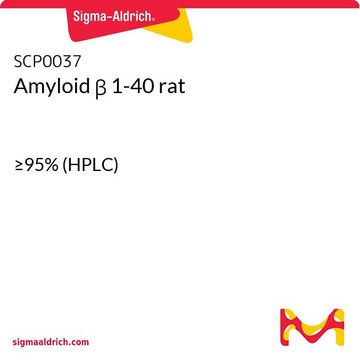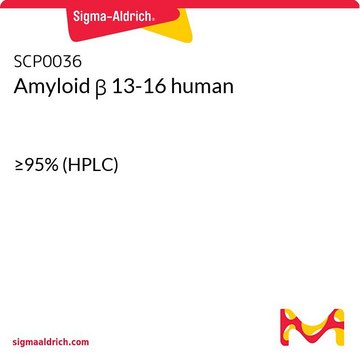SCP0033
Amyloid β 1-16 rat
Autenticatiper visualizzare i prezzi riservati alla tua organizzazione & contrattuali
About This Item
Formula empirica (notazione di Hill):
C80H115N25O27
Peso molecolare:
1858.92
Codice UNSPSC:
12352200
NACRES:
NA.32
Prodotti consigliati
Saggio
≥95% (HPLC)
Forma fisica
lyophilized
Composizione
Peptide Content, ≥75%
Condizioni di stoccaggio
protect from light
Temperatura di conservazione
−20°C
Amino Acid Sequence
Asp-Ala-Glu-Phe-Gly-His-Asp-Ser-Gly-Phe-Glu-Val-Arg-His-Gln-Lys
Applicazioni
Amyloid β (Aβ) refers to peptides derived from Amyloid precursor protein that vary in length from 36-43 amino acids. Aβ(s) peptides, their peptide fragments and mutated fragments are used to study a wide range of metabolic and regulatory functions including activation of kinases, regulation of cholesterol transport, function as a transcription factor, and regulators of inflammation. Aβ(s) peptides and their peptide fragments are also used to study oxidative stress, metal binding and mechanisms of protein cross-linking in the context of diseases such as Alzheimer′s disease and neurodegeneration.
Codice della classe di stoccaggio
11 - Combustible Solids
Classe di pericolosità dell'acqua (WGK)
WGK 3
Punto d’infiammabilità (°F)
Not applicable
Punto d’infiammabilità (°C)
Not applicable
Certificati d'analisi (COA)
Cerca il Certificati d'analisi (COA) digitando il numero di lotto/batch corrispondente. I numeri di lotto o di batch sono stampati sull'etichetta dei prodotti dopo la parola ‘Lotto’ o ‘Batch’.
Possiedi già questo prodotto?
I documenti relativi ai prodotti acquistati recentemente sono disponibili nell’Archivio dei documenti.
Maryam Bagheri et al.
Neurobiology of learning and memory, 95(3), 270-276 (2010-12-15)
Alzheimer's disease (AD) is a debilitating neurodegenerative disorder characterized by increased β-amyloid (Aβ) deposition and neuronal dysfunction leading to impaired learning and recall. Ageing, heredity, and induced oxidative stress are among proposed risk factors. The increased frequency of the disease
Aynun N Begum et al.
Journal of Alzheimer's disease : JAD, 15(4), 625-640 (2008-12-20)
The rat amyloid-beta (Abeta) intracerebroventricular infusion can model aspects of Alzheimer's disease (AD) and has predicted efficacy of therapies such as ibuprofen and curcumin in transgenic mouse models. High density lipoprotein (HDL), a normal plasma carrier of Abeta, is used
Lian Hong et al.
The journal of physical chemistry. B, 114(34), 11261-11271 (2010-08-10)
There is no consensus on the coordinating ligands for Cu(2+) by Abeta. However, the differences in peptide sequence between human and rat have been hypothesized to alter metal ion binding in a manner that alters Cu(2+)-induced aggregation of Abeta. Herein
Tania Araujo Viel et al.
Neurobiology of aging, 29(12), 1805-1814 (2007-06-16)
Although numerous inflammation pathways have been implicated in Alzheimer's disease, the involvement of the kallikrein-kinin system is still under investigation. We anatomically localized and quantified the density of kinin B(1) and B(2) receptors binding sites in the rat brain after
Yan Wang et al.
Neuropharmacology, 62(2), 871-881 (2011-10-01)
Alzheimer's disease (AD) is a progressive neurodegenerative disease characterized by the accumulation of β-sheet-rich amyloid oligomers or fibrils which are associated with cellular toxicity in the brain. Inhibition of Aβ aggregation could be a viable therapeutic strategy for slowing and/or
Il team dei nostri ricercatori vanta grande esperienza in tutte le aree della ricerca quali Life Science, scienza dei materiali, sintesi chimica, cromatografia, discipline analitiche, ecc..
Contatta l'Assistenza Tecnica.






